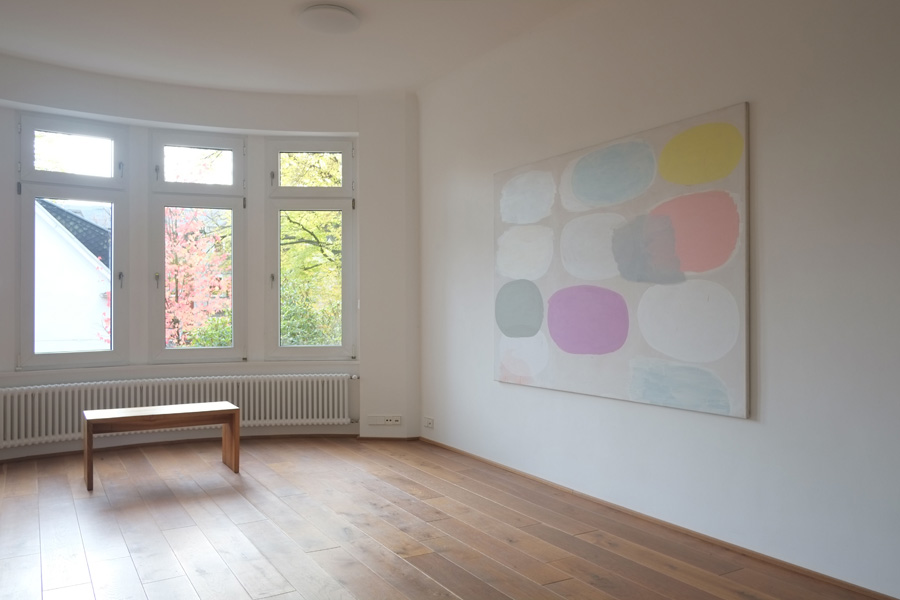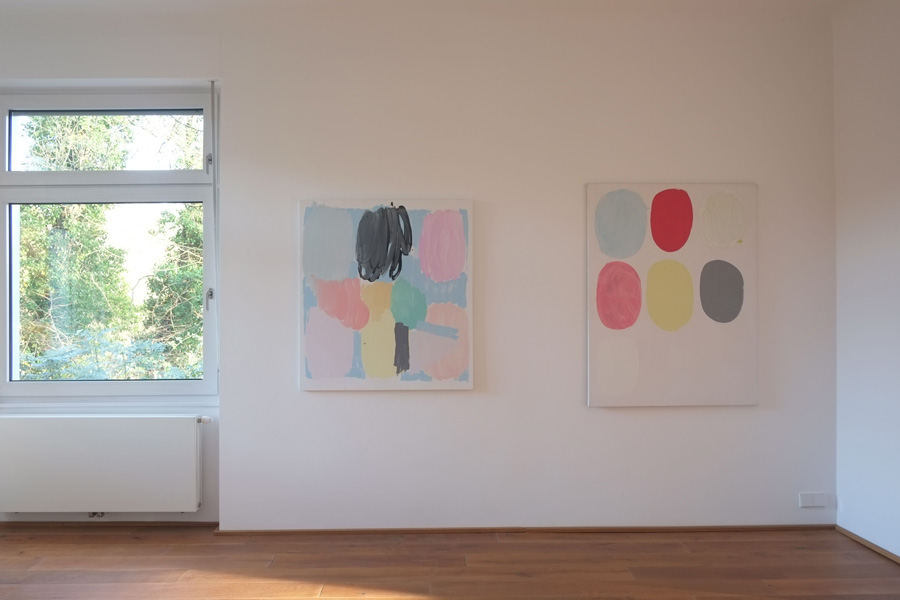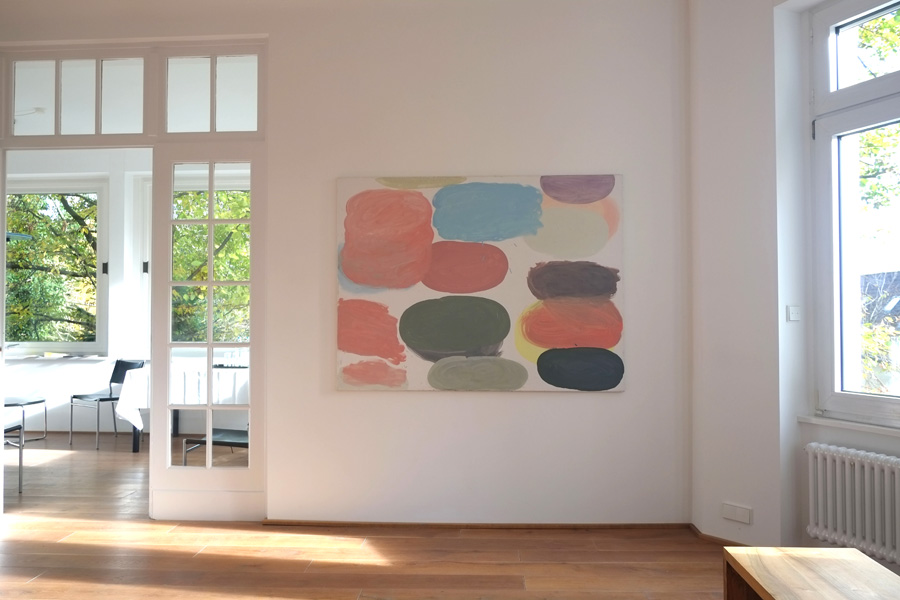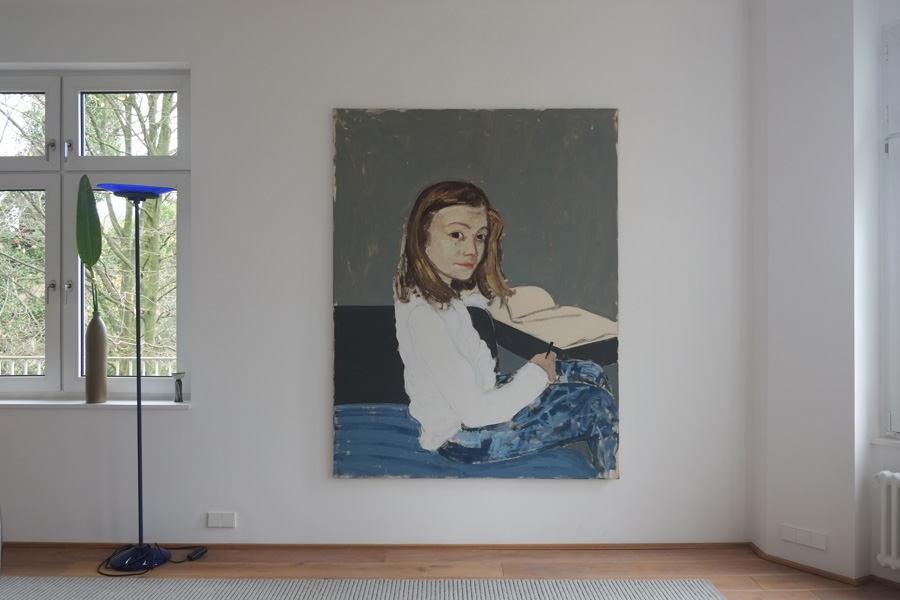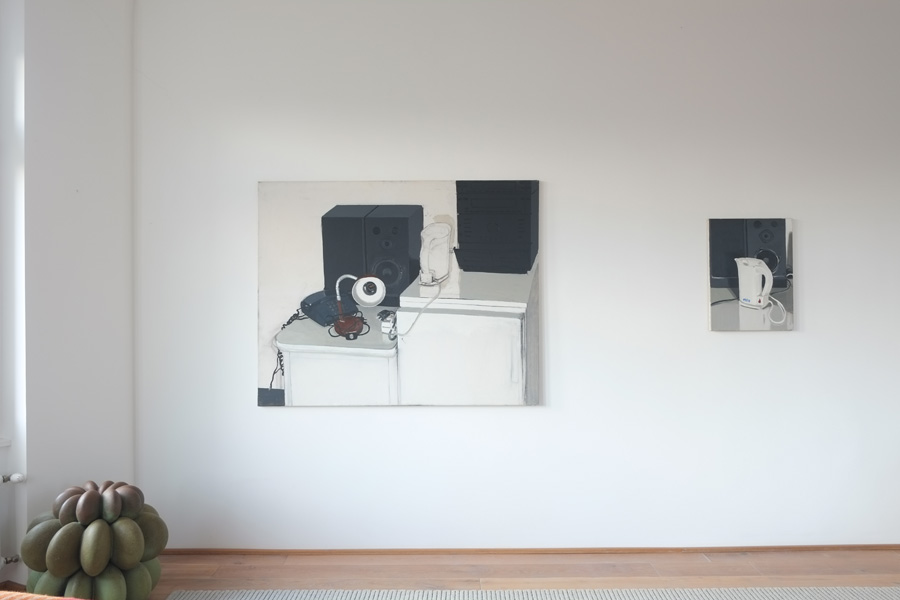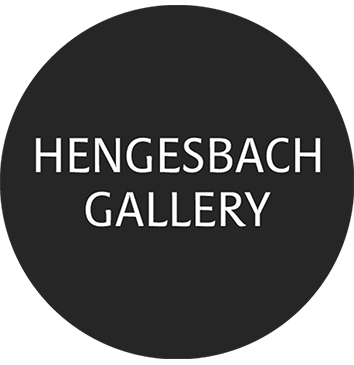Lorcan O´Byrne
September 4 – October 12, 2018
Lorcan O’Byrne began his painting career with portraits of friends and family. One might not expect the extreme sobriety, sharpness, and emotional distance with which he depicts them. In this early phase, his color palette is cool, leaning toward subtly muted tones—especially in the backgrounds. One senses that he thins his oil paint with turpentine, giving the colors a dulled, reduced luminosity in order to formulate tonal transitions and intermediate shades. Life, after all, is rarely radiant. In some paintings, there are faint indications of space or furniture, but these interiors feel aseptic—like examination rooms—stripped of all narrative or personal detail. The painterly style is restrained, reduced to the essential.
O’Byrne does not use his brush to capture distinctive features; rather, his brushwork derives its energy from the inherent reality of painting itself, as is fitting in a confident, post-modern artistic tradition. One senses O’Byrne’s intimate connection and passion for the materiality of painting.
Typically, the figures are placed in direct confrontation with the viewer. O’Byrne adopts the close-up framing familiar from cinema. Sometimes the heads are cropped, heightening the sense that the person is stepping directly into our field of vision. The eyes fix us intensely, relentlessly—at times piercingly. Sparse highlights on the faces enhance their vividness and physical presence within an otherwise abstract context. The facial features are defined with quick, assured brushstrokes. There are no embellishments or decorative elements. It is left to the viewer to interpret and animate these essential cues for themselves.
O’Byrne does not idealize. He adds no softening or warmth. His approach mirrors the unflinching precision of his great Irish predecessors in literature and art—Joyce, Beckett, Bacon: the modern human reduced to sheer existence in the laboratory of the probing gaze.
O’Byrne dissects the human figure into parts: facial planes, head, hair, body, limbs, garments in their layered arrangements—and interlocks them. Color takes the lead role here. It assigns visual volume to each part, through sharp, contrasting edges. These dividing lines and contour cuts between body segments—alongside the expression of the faces—contribute to the acuity of his images. They ensure that the individual blocks of color stand as autonomous visual agents in tension with one another.
The intensity of the color, its surface volume, and its varied textures determine the internal dialogue of the picture plane. The color volumes meet with precise alignment. In this way, the contradictions and oppositions within a person’s temperament can be expressed through the dialogical treatment of their bodily segments in color.
This conversation between color volumes and textures—as a dialogue about human dispositions and latent moods—can also be extended on another level: as a conversation among the objects around us, and about us. For the objects in our surroundings serve us and are arranged around us; they seem to absorb our moods or offer resistance.
After his portraits, Lorcan O’Byrne devoted himself consistently to still life. He favors objects with simple volumes—those that turn inward and remain silent, or those that reach outward and speak. These are containers or storage vessels: cabinets, cooling boxes, kettles, or also speakers and music devices.
The objects in his still lifes are neither centered nor arranged in a linear sequence. Rather, there is a perceptible search for a center or focal point—a balanced equilibrium whose success is implicitly questioned. The viewer might settle on the interpretation that what is shown here are only temporary states of a living environment—ones still awaiting a final arrangement or resolution. But does such resolution exist? Do O’Byrne’s pictorial worlds not instead reveal our lives as marked by latent unrest, persistent subliminal irritation, and a kind of inevitable displacement?
Though his objects are evidence of life contexts, these contexts are not developed into coherent scenes or narrative frameworks. Often the painting acts only sketchily, content with suggestion, or inserts an empty volume—again subjecting the domestic environment of material forces and interrelations to a sense of disruption. O’Byrne has almost completely withdrawn from color. Instead, he heightens the contrasts of light, reinforcing the poles of black and white. One might assume that these oppositions would result in electrical tensions—that mass and weight would be countered by lightness, that the poles might mark shifts in emotional tone. Yet this is not the case. These poles seem more like adjacent layers, kept at a distance by coloristic middle values placed between them. In their restrained austerity, these stratifications remain immovable—silent witnesses to our reflections, our contradictions. They neither evade us nor leave our side.
Over time, O’Byrne has further simplified his layered still lifes, reducing them to the central motif of the container, with its basic polarity of inside and outside. While the number of depicted objects has decreased, color has returned to the canvas in full intensity. These new paintings seduce the eye with their glowing hues, their sculpted shadowing, the authentic play of light and dark in the surrounding space, the mysterious, inaccessible interiors, and the diagonally tilted planes. Yet even here, the latent sense of dislocation remains.
In subsequent series, O’Byrne completely abandoned figurative models and focused on the direct dialogue between volumes of color—unobstructed by representation. How do they speak to one another? How do they influence mutual perception, attract the gaze, and distribute our visual attention across the picture plane—with varying degrees of adhesion to different textures and brightnesses?
In the beginning, O’Byrne chose oval color volumes which, unlike circles, possess an oriented direction while simultaneously radiating a balance between center and periphery. These *bubbles*, as he calls them, are not uniform in size; rather, they find their dimensions in dialogue with one another during the painting process. The picture plane is not evenly filled with these bubbles—O’Byrne seeks to determine their distribution and visual weight organically, in the course of painting.
When the traces of a completely overpainted bubble remain faintly visible, it becomes clear that the circular movement of painting in search of its own correctness is O’Byrne’s central concern. What matters is not a pre-fixed composition, but the ongoing negotiation of visual equilibrium—a process that mirrors the human search for balance in life.
In his most recent works, these bubbles have transformed into fields of differentiated color blending, where the boundaries between areas remain perceptible. This painting is no longer about representation, but about uncovering and testing the very criteria by which moments of balance—however fleeting or unstable—can be found and made visible.
Installation Views
